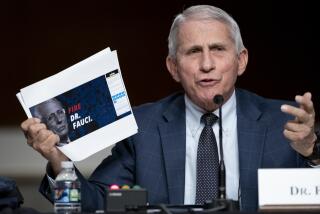AIDS Experts Strongly Doubt New Virus Exists
- Share via
ATLANTA — Despite scattered but increasing reports of an AIDS-like illness among people not infected with the human immunodeficiency virus, leading scientists expressed profound skepticism Friday that another virus is the likely culprit.
At an urgent meeting called by the Centers for Disease Control to gather up-to-date information on the mysterious immune system abnormalities, scientists said that evidence supporting a viral cause of the illnesses is weak. Moreover, analysis has revealed that some of the ill individuals may have immune system weaknesses explained by tuberculosis or other infections.
While emphasizing that he was “keeping an open mind,” Dr. Anthony Fauci, the top AIDS official for the National Institutes of Health, said the suggestions of viruses are inconsistent and “can be explained by a variety of technical factors. . . . There is nothing definitive about what we have heard.”
Fauci noted that no one has been able to replicate the findings of UC Irvine scientist Dr. Sudhir Gupta, who last month reported evidence of viral particles in the blood samples of several patients with the AIDS-like disease.
Since wide publicity at the international AIDS conference last month, the issue has dominated discussions among AIDS researchers and caused significant public anxiety because of fears about the safety of the blood supply. Researchers say HIV can be screened in almost all cases to prevent tainted blood from being used in transfusions.
Such concerns prompted the CDC to hold the meeting, which included the first detailed scientific presentations by the three American researchers who have been searching for AIDS-like viruses. Also presented were updates from the CDC and others on patients with unexplained depletion of “CD4 T-lymphocytes” but no evidence of HIV infection. HIV causes the acquired immune deficiency syndrome by destroying these key immune system cells.
Researchers were urged to consider all possibilities, including viruses of types significantly different than HIV, other germs, genetic factors or environmental agents.
Overall, the new data presented in Atlanta suggests that researchers may be dealing with a heterogenous group of disorders, some potentially serious, others not.
What scientists heard Friday “did not give us any information to believe that we are dealing with an infectious agent (such as a virus) that is causing a transmissible disease,” Fauci said.
Researchers heard reports of people who have the immune system abnormality but are not ill, and cases where the immune system abnormality has gone away over time. Other presentations suggested that the affliction could be caused by tuberculosis or other infections that can depress the immune system.
In sharp contrast to HIV infection, in which the immune system undergoes a steady downhill course, the immune deficiency appears to remain stable over time in many of the cases presented Friday.
Dr. Gerald Quinnan of the Food and Drug Administration said it would be premature to consider additional screening tests for the blood supply until there is evidence that the immune system abnormalities being studied are transmissible through blood transfusions.
Dr. Harold Jaffe, acting director of the Division of HIV/AIDS at the Centers for Disease Control, said: “At this point, we don’t know enough to make public health recommendations related to blood safety. It is not clear that any of these investigators have identified a virus.”
The meeting was highlighted by the presentations of the three investigators--Dr. David Ho, director of the Aaron Diamond Research Center in New York City, Gupta of UC Irvine, and Dr. Jeffrey Laurence of Cornell Medical Center in New York City.
Ho has looked for a virus in 17 patients with low CD4 counts and no HIV. His results have been “completely negative” in 15 cases. In two patients, the results suggested a viral enzyme known as reverse transcriptase. In one of these patients the low CD4 count went away, as well as the viral enzyme activity. In neither of these patients could a virus be seen under an electron microscope, Ho said.
Laurence has searched for a virus in five patients. The one patient who has evidence of reverse transcriptase activity also has preliminary evidence of viral fragments that are identical to HIV, said Gerald Meyers of the HIV sequence database at Los Alamos, N. M., who has analyzed the sequences. This suggests that the patient may have been infected with HIV, but for some reason this is not detected in normal blood tests. Laurence said Meyers’ finding was preliminary and experiments needed to be repeated.
Laurence’s research team has also not found evidence for whole viral particles, despite examining several hundred electron microscope photographs. “That is disappointing,” Laurence said.
In research that was widely publicized during the international AIDS conference last month, Gupta has found evidence of reverse transcriptase activity and viral-like particles in two people: a 66-year-old woman with Pneumocystis carinii pneumonia, and her healthy 38-year-old daughter.
But experts pointed out that viral-like particles can be seen under an electron microscope in other diseases, and even in normal human placenta. Howard Temin, a Nobel laureate from the University of Wisconsin, expressed very strong skepticism. He suggested that the viral-like particles might have originated in the laboratory cells Gupta used to grow the virus, not from the patients’ blood. He also said there was inadequate evidence that the particles were infectious.
The CDC has named the new syndrome “idiopathic CD4+ T-lymphocytopenia,” which is medical parlance for an unexplained low concentration of CD4-lymphocytes in the blood. To fit the diagnosis, patients must have CD4 cell levels of less than 300 cells per cubic millimeter of blood on two occasions. They must also be free of HIV infection and have no known condition associated with T-cell depletion. A normal CD4 value is between 800 and 1,200 cells.
Some patients discussed at the meeting have been ill with a variety of infections while others have no symptoms, said Dr. Martha Rogers of the CDC.
So far, the CDC has evaluated 30 cases. Other participants at the meeting discussed about 50 more potential cases. Although these numbers are expected to increase as more physicians report possible cases, they are dwarfed by the more than 230,000 reported AIDS cases in the United States.
The 30 CDC cases come from 15 states, including California, and all but one of the patients are living, Rogers said. More than half had no reported risk factors for HIV infection, which include blood transfusions, homosexual intercourse or intravenous drug use. There is “no readily apparent linkage, contact, or clustering of . . . cases; they are widely scattered geographically,” she said.
By comparison, early AIDS cases in the United States were concentrated in San Francisco, Los Angeles and New York City and linkages between patients were readily established.
In addition, to date there is no evidence of illness or reductions in CD4 cell counts in the contacts of patients, such as their sex partners, household contacts or blood donors, Rogers said. Before blaming an infectious agent, such as a virus or bacteria, it is essential to establish such epidemiological links, as was done early in the AIDS epidemic.






